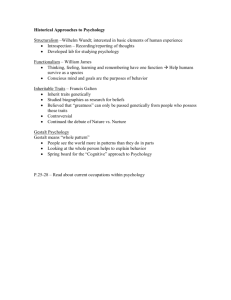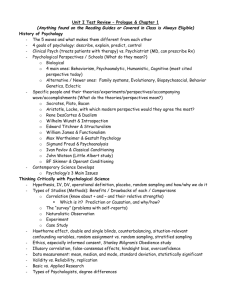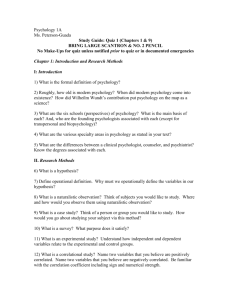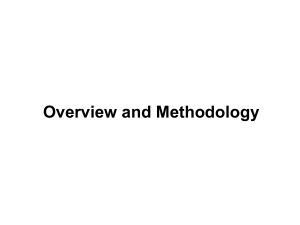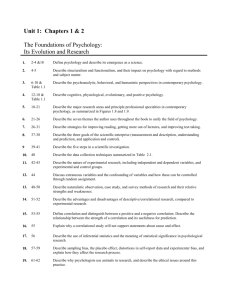AP Psychology Unit 2 Test Research Methods Psychologists
advertisement
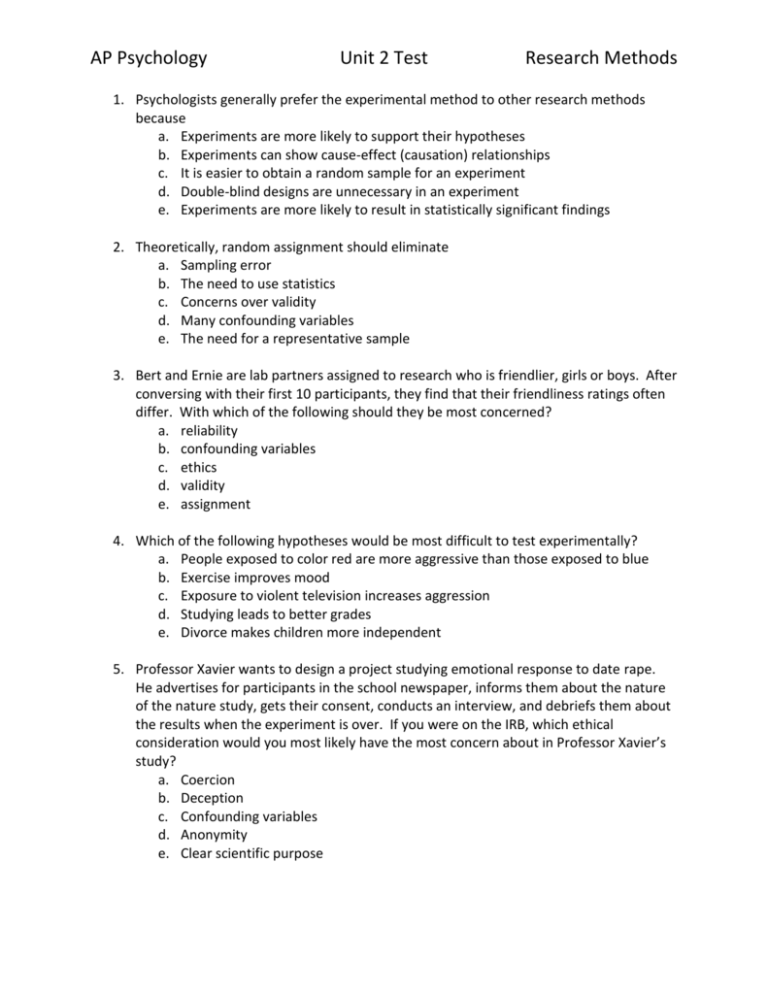
AP Psychology Unit 2 Test Research Methods 1. Psychologists generally prefer the experimental method to other research methods because a. Experiments are more likely to support their hypotheses b. Experiments can show cause-effect (causation) relationships c. It is easier to obtain a random sample for an experiment d. Double-blind designs are unnecessary in an experiment e. Experiments are more likely to result in statistically significant findings 2. Theoretically, random assignment should eliminate a. Sampling error b. The need to use statistics c. Concerns over validity d. Many confounding variables e. The need for a representative sample 3. Bert and Ernie are lab partners assigned to research who is friendlier, girls or boys. After conversing with their first 10 participants, they find that their friendliness ratings often differ. With which of the following should they be most concerned? a. reliability b. confounding variables c. ethics d. validity e. assignment 4. Which of the following hypotheses would be most difficult to test experimentally? a. People exposed to color red are more aggressive than those exposed to blue b. Exercise improves mood c. Exposure to violent television increases aggression d. Studying leads to better grades e. Divorce makes children more independent 5. Professor Xavier wants to design a project studying emotional response to date rape. He advertises for participants in the school newspaper, informs them about the nature of the nature study, gets their consent, conducts an interview, and debriefs them about the results when the experiment is over. If you were on the IRB, which ethical consideration would you most likely have the most concern about in Professor Xavier’s study? a. Coercion b. Deception c. Confounding variables d. Anonymity e. Clear scientific purpose AP Psychology Unit 2 Test Research Methods 6. Some psychologists consider Stanley Milgram’s obedience studies to be unethical because of which consideration? a. Improper sampling procedure b. Risk of long-term harm c. Clear scientific purpose d. Debriefing e. Anonymity 7. One of the principal differences between the ethical guidelines for human and animal research is a. Human subjects can be deceived for experimental purposes and animals cannot b. Animal subjects can be placed at much greater physical risk than human subjects c. Human subjects must be chosen much more carefully than animal subjects d. If humans might physically suffer because of the study, the suffering must be minimal in contrast to animal studies where any amount of suffering is ethical, if it helps to further a clear scientific purpose e. Environmental conditions for human studies must be monitored much more closely than they are in an animal study 8. Kermit scored 145 on an IQ test with a mean of 100 and a standard deviation of 15. What is his z score? a. -3 b. -1.5 c. 15 d. +1.5 e. +3 9. What is the median of the following distribution: 6, 2, 9, 4, 7, 3? a. 4 b. 5 c. 5.5 d. 6 e. 6.5 10. Gonzo scores a perfect 100 on a test that everyone else fails. If we were to graph this distribution, it would be a. Symmetrical b. Normal c. Positively skewed d. Negatively skewed e. A straight line 11. Beaker hypothesizes that a new drug he has just invented will enhance mice’s memories. He feeds the drug to the experimental group and gives the control group a AP Psychology Unit 2 Test Research Methods placebo. He then times the mice as they learn to run through a maze. In order to know whether his hypothesis has been supported, Beaker would need to use a. Scatter plot b. Descriptive statistics c. Histograms d. Inferential statistics e. Means-ends analysis 12. Which of the following is an example of random sampling? a. Picking out of a hat to assign each of three classes to an experimental condition b. Having a computer generate a random list of 100 high school students c. Approaching any 50 students during sixth-period lunch a. I only b. II only c. III only d. I & II e. I, II, & III 13. Dr. Bunsen Honeydew conducts an experiment to see whether fear makes mice run through mazes faster. He first selected a sample of 60 mice and then divided them into a control group and an experimental group. Which cannot be a confounding variable? a. How fast the mice are at the start b. When the mice run the maze c. The population from which he selected his subjects d. How frightened the mice are before the experiment e. Where the mice run the maze 14. Fozzie, a nursery school worker, hypothesizes that boys have fights with the finger paints more than girls do. He tests his hypothesis by casually watching the fingerpainting table for three days. What method is he using? a. Field experiment b. Informal survey c. Case study d. Naturalistic observation e. Ethnography 15. Janice collects survey data that indicates that students who spend more time preparing for the AP test tend to score better than other students. Janice can now conclude that a. Studying improves exam grades b. A relationship exists between studying and exam grades c. A significant correlation exists between studying and exam grades d. Anyone who does not study will do poorly on the exam e. Better students tend to study more AP Psychology Unit 2 Test Research Methods 16. In a study of effects of alcohol on driving ability, the control group should be given a. A high dosage of alcohol b. One-half the dosage given the experimental group c. A driving test before and after drinking alcohol d. No alcohol at all e. One-third the dosage given the experimental group 17. A scientific explanation that remains tentative until it has been adequately tested is called a(n) a. Theory b. Law c. Hypothesis d. Experiment e. Guess 18. A study to determine the degree of relationship between two events is called a. Case study b. Naturalistic observation c. Double-blind procedure d. Correlational study e. Controlled experiment 19. A teacher believes that one group of children is very bright and that a second is below average in ability. Actually, the groups are identical, but the first group progresses more rapidly than the second. This demonstrates a. The self-fulfilling prophecy b. The placebo effect in a natural experiment c. Observer bias in naturalistic observation d. The ethical problems of field experiments e. Hindsight bias 20. In an experiment to find out if taking ginseng increases IQ scores, the IQ scores would be a. The independent variable b. A confounding variable c. The dependent variable d. An extraneous variable e. A mean 21. To prevent ethical abuse in psychological research, the APA has suggested that a. Psychologists must treat all subjects with respect and concern for the subject's dignity b. Psychologists must avoid deception with using human subjects c. All data collected from a person must be made public AP Psychology Unit 2 Test Research Methods d. All psychological harm to subjects must be corrected by counseling e. All subjects come from institutionalized populations 22. A common method for selecting representative samples is to select them a. Randomly from a larger population b. Strictly from volunteers c. By threatening or coercing institutionalized populations d. Using data ranking them for suitability e. From a list Refer to the following & your knowledge of psychology to answer question #23 & #24: Students will be able to read a statement printed in the Comic Sans font faster than the same statement written in the Lucida Calligraphy font. 23. This statement is a(n) a. Hypothesis b. Theory c. Replication d. Operational definition e. Correlation 24. The dependent variable in an experiment based on the statement would be a. The statement written in Comic Sans font b. The statement written in Lucida Calligraphy font c. The length of time it takes students to read the statements d. The students who read the Comic Sans font e. The students who read the Lucida Calligraphy font Refer to the following & your knowledge of psychology to answer question #25 & #26: When subjects in the experimental group put a puzzle piece in the wrong place, the experimenter unconsciously winced. The experimenter did not wince when subjects in the control group put a piece in the wrong place. 25. The wincing of the experimenter must be eliminated because it is a. Fraudulent b. A demand characteristic c. A placebo effect d. A confabulation e. A confounding variable 26. One method to eliminate the wincing of the experimenter is by instituting a. The experimenter expectancy effect b. The single-blind procedure c. The double-blind procedure d. The placebo effect e. Counterbalancing AP Psychology Unit 2 Test Research Methods 27. Which of the following coefficients of correlation indicates the strongest relationship between two sets of variables? a. 0.00 b. +.05 c. -.98 d. +1.2 e. -.44 28. A researcher determines that the crime rate in a large city fluctuates with the phases of the moon. He concludes that the gravitational pull of the moon influences human behavior. He has committed what error? a. He incorrectly inferred correlation from causation b. He incorrectly inferred causation from correlation c. He failed to measure the gravitational pull to test his hypothesis d. He has overlooked the placebo effect e. He has overlooked the Hawthorne effect 29. Of the following, which research method would be most appropriate for investigating the relationship between political party membership and attitude toward the death penalty? a. Controlled experiment b. Quasi-experiment c. Naturalistic observation d. Survey e. Case study 30. A set of exact procedures/descriptions that represent particular variables are called a. Abstract definitions b. Operational definitions c. Case studies d. Defining characteristics e. Hypotheses Refer to the following & your knowledge of psychology to answer question #31, #32, & #33: Ms. Pigge owns a business with nine other employees. Ms. Pigge’s annual salary is $90,000. Her manager’s salary is $60,000. Of her other employees, three earn $25,000 each and five earn $15,000 each. 31. The range of this distribution is a. $75,000 b. $50,000 c. $25,000 d. $20,000 e. $15,000 AP Psychology Unit 2 Test Research Methods 32. For this distribution, the mean is a. Lower than both the median and the mode b. Lower than the median, but higher than the mode c. Lower than the mode, but higher than the median d. Higher than both median and mode e. The same as the median 33. The frequency polygon for this distribution is a a. Normal curve b. Positively skewed line graph c. Negatively skewed line graph d. Bar graph e. Scatterplot 34. To investigate the effects of a particular study method on student performance, two different methods are tried, each with a different group of subjects. If only the experimenter knows which method is under investigation, the procedure being used is described as a. Double-blind procedure b. Single-blind procedure c. Hawthorne effect d. Placebo effect e. Representative sampling 35. A correlation coefficient of -1.09 indicates a(n) a. Strong positive correlation b. Strong negative correlation c. Strong cause/effect relationship d. No relationship e. An error in computation 36. The effects of brain injury on personality would usually be investigated by the use of the a. Experimental method b. Case study method c. Naturalistic observation d. Survey method e. Correlational study 37. In a weight-reduction experiment, an overweight individual was given what the researcher called a new type of diet pill that would help curb the desire to eat. In fact, the pill really contained powdered milk, but ever since the individual started taking the diet pill, he has reported that his desire to eat has decreased. This illustrates the a. Curvilinear relationship b. Effect of confounding variables AP Psychology Unit 2 Test Research Methods c. Placebo effect d. Independent variable effect e. Effect of dependent variable 38. The control group and the experimental group in an experiment are treated exactly the same except for a. The dependent variable b. The independent variable c. The confounding variables d. The Hawthorne effect e. The placebo effect 39. The question “Is intelligence more influenced by heredity or experience?” deals with a big issue in psychology known as a. Stability vs. change b. Mind-body dualism c. Rationality vs. irrationality d. Structure vs. function e. Nature vs. nurture 40. What psychological approach is most concerned with the importance of encoding, storing, and retrieving information? a. Information technology b. Behavioral approach c. Psychodynamic approach d. Biological approach e. Cognitive approach 41. If Aristotle and Locke, who both believed that what we know is acquired from experience, were alive today, they would best agree with the a. Behavioral approach b. Psychoanalytic approach c. Humanistic approach d. Biological approach e. Psychodynamic approach 42. You are at a lecture about the history of psychology and the speaker states that Wilhelm Wundt’s theory of structuralism was the first scientific psychological theory. On what historical fact might the speaker be basing her or his argument? a. Wundt was internationally known at the time, and this lent credence to his theory in the scientific community. b. Wundt studied under Ivan Pavlov for his graduate training, and Pavlov required scientific methods to be used. AP Psychology Unit 2 Test Research Methods c. Structuralism was based on the results of his introspection experiments, so it is, at least in part, empirical. d. Structuralism was based on careful anecdotes gathered from Wundt’s extensive clinical career. e. Wundt was the first person to study psychology in an academic setting. 43. Doctor Jekyll explains to a client that his feelings of hostility toward a coworker are most likely caused by the way the client interprets the coworker’s actions and the way he thinks that people should behave at work. Dr. Jekyll is most likely working from what perspective? a. Behavioral b. Cognitive c. Psychoanalytic d. Humanist e. Social-cultural 44. The research method Wilhelm Wundt used is called a. Introspection b. Structuralism c. Naturalistic observation d. Inferential e. Scientific 45. B. F. Skinner introduced the idea of ______________ to the paradigm of behaviorism. a. Unconscious thinking b. Reinforcement c. Conditioning d. Defense mechanisms e. Introspection 46. Behaviorists explain human thought and behavior as a result a. Past conditioning b. Unconscious behavioral impulses c. Natural selections d. Biological processes e. Individual choice 47. The evolutionary approach emphasizes changes in behavior a. Resulting from cloning b. Resulting from changes in chromosome levels c. On the species level d. Within cultural groups e. That show how behavior of monkeys compares to behavior of people AP Psychology Unit 2 Test Research Methods 48. Dr. Herbert West believes that poverty lies at the root of most of his inner-city clients’ mental illnesses. This perspective is best labeled a. Humanistic b. Social-cultural c. Biological d. Cognitive e. Behavioral 49. The humanist perspective emphasizes a. Free will, self-image, and self-actualization b. Determinism, the unconscious, and biological drives c. Natural selection and practical skills d. The idea that the environment is the key causal matrix e. Behaviors and conditioning 50. An experimenter conducts an experiment on the effects of a drug to control hallucinations. He declares the results to be “statistically significant,” which usually means that a. even though appropriate statistics were used, no differences could be detected between experimental and control groups b. the results have important implications for theory or practice c. differences between experimental and control groups of this size occur by chance only 5 times out of 100 (or less) d. differences between experimental and control groups were so large they could never occur by chance alone e. differences between experimental and control groups of this size occur by chance only 25 times out of 100 (or less)


